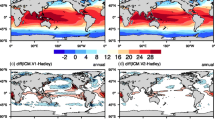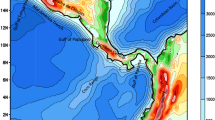Abstract
This study discusses the representation of the intraseasonal oscillation (ISO) in three simulations with the ECHAM4 atmosphere general circulation model (GCM). First, the model is forced by AMIP sea surface temperatures (SST), then coupled to the OPYC3 global ocean GCM and third forced by OPYC3 SSTs to clarify possible air-sea interactions and connections of the ISO and the ENSO cycle. The simulations are compared to ECMWF reanalysis data and NOAA outgoing longwave radiation (OLR) observations. Although previous studies have shown that the ECHAM4 GCM simulates an ISO-like oscillation, the main deficits are an overly fast eastward propagation and an eastward displacement of the main ISO activity, which is shown with a composite analysis of daily data between 1984 to 1988 for the reanalysis and the AMIP simulation, 25 years of the coupled integration, and a five year subset of the coupled SST output used for the OPYC3 forced atmosphere GCM experiment. These deficits are common to many atmospheric GCMs. The composites are obtained by principal oscillation pattern (POP). The POPs are also used to investigate the propagation speed and the interannual variability of the main ISO activity. The present coupled model version reveals no clear improvements in the ISO simulation compared to the uncoupled version forced with OPYC3 SSTs, although it is shown that the modeled ISO influences the simulated high-frequency SST variability in the coupled GCM. Within the current analysis, ECHAM4 forced by AMIP SSTs provides the most reasonable ISO simulation. However, it is shown that the maximum amplitudes of the annual cycle of the ISO variability in all analyzed model versions are reached too late in the year (spring and summer) compared to the observations (winter and spring). Additionally, the ENSO cycle influences the interannual variability of the ISO, which is revealed by 20 years of daily reanalysis data and 100 years of the coupled integration. The ENSO cycle is simulated by the coupled model, although there is a roughly 1 K cold bias in the East Pacific in the coupled model. This leads to a diminished influence of the ENSO cycle on the spatial variability of the modeled ISO activity compared to observations. This points out the strong sensitivity of the SST on the ISO activity. Small biases in the SST appear to cause large deterioration in the modeled ISO.

















Similar content being viewed by others
References
Bacher A, Oberhuber JM, Roeckner E (1998) ENSO dynamics and seasonal cycle in the tropical Pacific as simulated by the ECHAM4/OPYC3 coupled general circulation model. Clim Dyn 14: 431–450
Bladé I, Hartmann DL (1993) Tropical intraseasonal oscillations in a simple nonlinear model. J Atmos Sci 50: 2922–2939
Chen TC, Chen JM (1997) On the relationship between the streamfunction and velocity potential of the Madden-Julian oscillation. J Atmos Sci 54: 679–685
Delcroix T, Dewitte B, du Penhoat Y, Masia F, Picaut J (2000) Equatorial waves and warm pool displacements during the 1992–1998 El Nino Southern Oscillation events: observation and modeling. J Geophys Res 105: 26,045–26,062
Dommenget D, Latif M (2002) A cautionary note on the interpretation of EOF. J Clim 15: 216–225
Ferranti L, Palmer TN, Molteni F, Klinker E (1990) Tropical-extratropical interaction associated with the 30–60 day oscillation and its impact on medium and extended range prediction. J Atmos Sci 47: 2177–2199
Flatau M, Flatau PJ, Phoebus P, Niiler PP (1997) The feedback between equatorial convection and local radiative and evaporative processes: the implications for intraseasonal oscillations. J Atmos Sci 54: 2373–2386
Gallagher F, von Storch H, Schnur R, Hannoschoeck G (1991) The POP manual. Techn Rep 1, Deutsches Klimarechenzentrum, Hamburg, Germany, pp 66
Graham N, Barnett TP (1987) Observations of sea surface temperature and convection over tropical oceans. Science 238: 657–660
Gruber A, Krueger AF (1984) Status of the NOAA outgoing long-wave radiation data set. Bull Am Meteorol Soc 65: 958–962
Gualdi S, Navarra A, von Storch H (1997) Tropical intraseasonal oscillation appearing in operational analysis and in a family of general circulation models. J Atmos Sci 54: 1185–1202
Gualdi S, Navarra A, Tinarelli G (1999) The interannual variability of the Madden-Julian oscillation in an ensemble of GCM simulations. Clim Dyn 15: 643–658
Hayashi YY, Golder DG (1993) Tropical 40–50- and 25–30-day oscillations appearing in realistic and idealised GFDL climate models and the ECMWF dataset. J Atmos Sci 50: 464–494
Hendon HH (2000) Impact of air-sea coupling on the Madden-Julian oscillation in a general circulation model. J Atmos Sci 57: 3939–3952
Hendon HH, Salby ML (1994) The life cycle of the Madden-Julian oscillation. J Atmos Sci 51: 2225–2237
Inness PM, Slingo JM, Woolnough SJ, Neale RB, Pope VD (2001) Organization of tropical convection in a GCM with varying vertical resolution; implications for the simulation of the Madden-Julian oscillation. Clim Dyn 17: 777–793
Jones C (2000) Occurrence of extreme precipitation events in California and relationships with the Madden Julian oscillation. J Clim 13: 3576–3587
Jones C, Waliser DE, Gautier C (1998) The influence of the Madden-Julian oscillation on ocean surface heat fluxes and sea surface temperature. J Clim 11: 1057–1072
Kemball-Cook SR, Weare BC (2001) The onset of convection in the Madden-Julian oscillation. J Clim 14: 780–793
Kemball-Cook SR, Wang B, Fu X (2002) Simulation of the intraseasonal oscillation in the ECHAM-4 model: the impact of coupling with an ocean model. J Atmos Sci 59: 1433–1453
Kessler WS, McPhaden M, Weickmann KM (1995) Forcing of intraseasonal Kelvin waves in the equatorial Pacific. J Geophys Res 100: 10,613–10,631
Knutson TR, Weickmann KM (1987) 30-60 day atmospheric oscillations: composite life cycles of convection and circulation anomalies. Mon Weather Rev 115: 1407–1436
Koblinsky C, Ray R, Beckley B, Brenner A, Tsaoussi L, Wang Y (1999) NASA ocean altimeter Pathfinder project. Report 2: data set validation. Technical memorandum, NASA/TM-1999-209230
Lau KM, Sui CH (1997) Mechanisms of short-term sea surface temperature regulation: observations during TOGA COARE. J Clim 10: 465–472
Liebmann B, Smith CA (1996) Description of a complete (interpolated) outgoing longwave radiation dataset. Bull Am Meteorol Soc 77: 1275–1277
Liess S (2002) Model studies of the 30–60 day oscillation. PhD thesis, Max-Planck-Institut für Meteorologie, Hamburg, Germany, pp 143
Liess S, Bengtsson L (2004) The intraseasonal oscillation in ECHAM Part II: sensitivity studies. Clim Dym DOI 10.1007/s00382-004-0407-z
Madden RA, Julian PR (1971) Detection of a 40–50 day oscillation in the zonal wind in the tropical Pacific. J Atmos Sci 28: 702–708
Madden RA, Julian PR (1972) Description of global-scale circulation cells in the tropics with a 40–50 day period. J Atmos Sci 29: 1109–1123
Madden RA, Julian PR (1994) Observations of the 40-50-day tropical oscillation – a review. Mon Weather Rev 122: 814–837
Maloney ED, Hartmann DL (2001) The sensitivity of intraseasonal variability in the NCAR CCM3 to changes in convective parametrization. J Clim 14: 2015–2034
Matthews AJ (2000) Propagation mechanisms for the Madden-Julian oscillation. Q J R Meteorol Soc 126: 2637–2651
Matthews AJ, Hoskins BJ, Slingo JM, Blackburn M (1996) Developement of convection along the SPCZ within a Madden-Julian oscillation. Q J R Meteorol Soc 122: 669–688
McPhaden MJ, Taft BA (1988) Dynamics of seasonal and intraseasonal variability in the eastern equatorial Pacific. J Phys Oceanogr 18: 1713–1732
Myers DS, Waliser DE (2003) Three-dimensional water vapor and cloud variations associated with the Madden-Julian oscillation during northern hemisphere winter. J Clim 16:929–950
Nakazawa T (1999) MJO–a key component in the atmosphere for triggering ENSO. In: Conference on the TOGA Coupled Ocean-Atmosphere Response Experiment (COARE), Boulder, Colorado, USA, 7–14 July 1998, COARE-98. Geneva, Switzerland, World Meteorological Organization, WMO/TD 940, pp 165–166
Newman M, Sardeshmukh PD, Bergman JW (2000) An assessment of the NCEP, NASA, and ECMWF reanalyses over the tropical west Pacific warm pool. Bull Am Meteorol Soc 81: 41–48
Nordeng TE (1994) Extended versions of the convective parametrization scheme at ECMWF and their impact on the mean and transient activity of the model in the tropics. Tech Mem. 206, ECMWF Research Department, European Centre for Medium-Range Weather Forecasts, Reading, UK, pp 41
Picaut J, Delcroix T (1995) Equatorial wave sequence associated with warm pool displacements during the 1986–1989 El Nino-La Nina. J Geophys Res 100: 18,393–18,408
Reynolds RW, Smith TM (1994) Improved global sea surface temperature analysis using optimum interpolation. J Clim 7: 929–948
Roeckner E, Arpe K, Bengtsson L, Christoph M, Claussen M, Dümenil L, Esch M, Giorgetta M, Schlese U, Schulzweida U (1996a) The atmospheric general circulation model ECHAM4: model description and simulation of present-day climate. Report 218, Max-Planck-Institut für Meteorologie, Hamburg, Germany, pp 90
Roeckner E, Oberhuber JM, Bacher A, Christoph M, Kirchner I (1996b) ENSO variability and atmospheric response in a global coupled atmosphere-ocean GCM. Clim Dyn 12: 737–754
Rui H, Wang B (1990) Development characteristics and dynamic structure of tropical intraseasonal convection anomalies. J Atmos Sci 47: 357–379
Salby ML, Hendon HH (1994) Intraseasonal behavior of clouds, temperature, and motion in the tropics. J Atmos Sci 51: 2207–2224
Slingo JM, Rowell DP, Sperber KR, Nortley F (1999) On the predictability of the interannual behaviour of the Madden-Julian oscillation and its relationship with El Niño. Q J R Meteorol Soc 125: 583–609
Slingo JM, Sperber KR, Boyle JS, Ceron JP, Dix M, Dugas B, Ebisuzaki W, Fyfe J, Gregory D, Gueremy JF, Hack J, Harzallah A, Inness P, Kitoh A, Lau WKM, McAvaney B, Madden R, Matthews A, Palmer TN, Park CK, Randall D, Renno N (1996) Intraseasonal oscillations in 15 atmospheric general circulation models: results from an AMIP diagnostic subproject. Clim Dyn 12: 325–357
Sperber KR, Slingo JM, Inness PM, Lau WKM (1997) On the maintenance and initiation of the intraseasonal oscillation in the NCEP/NCAR reanalysis and the GLA and UKMO AMIP simulations. Clim Dyn 13: 769–795
Tiedtke M (1989) A comprehensive mass flux scheme for cumulus parametrization in large scale models. Mon Weather Rev 117: 1779–1800
van Oldenborgh GJ (2000) What caused the 1997–1998 El Niño? Mon Weather Rev 128: 2601–2607
von Storch H, Bruns T, Fischer-Bruns I, Hasselmann K (1988) Principal oscillation pattern analysis of the 30- to 60-day oscillation in general circulation model equatorial troposphere. J Geophys Res 93: 11,022–11,036
von Storch H, Bürger G, Schnur R, von Storch J (1995) Principal oscillation patterns: a review. J Clim 8: 377–400
Waliser DE, Lau KM, Kim JH (1999) The influence of coupled sea surface temperatures on the Madden-Julian oscillation: a model perturbation experiment. J Atmos Sci 56: 333–358
Wang B, Rui H (1990) Synoptic climatology of transient tropical intraseasonal convection anomalies. Meteorol Atmos Phys 44: 43–61
Wang B, Xie X (1998) Coupled modes of the warm pool climate system. Part I: the role of air-sea interaction in maintaining Madden-Julian oscillation. J Clim 11: 2116–2133
Weickmann KM, Kiladis GN, Sardeshmukh PD (1997) The dynamics of intraseasonal atmospheric angular momentum oscillations. J Atmos Sci 54: 1445–1461
Zhang C (1997) Intraseasonal variability of the upper-ocean thermal structure observed at 0 degrees and 165 degrees E. J Clim 10: 3077–3092
Zhang C, Hendon HH (1997) Propagating and standing components of the intraseasonal oscillation in tropical convection. J Atmos Sci 54: 741–752
Zhang C, Hendon HH, Kessler WS, Rosati AJ (2001) Meeting summary: a workshop on the MJO and ENSO. Bull Am Meteorol Soc 82: 971–976
Acknowledgements
The authors would like to thank Silvio Gualdi, Pete M. Inness, Duane E. Waliser and the staff at the Max-Planck Institute for Meteorology and the State University of New York at Stony Brook for helpful comments and discussions. The ECMWF made the radiosonde measurements at Singapore airport available as part of the MARS dataset. The ECMWF reanalysis data were supplied by the European Centre for Medium range Weather Forecast in cooperation with the German Climate Computing Center (DKRZ). The NCEP reanalysis and the NOAA data were kindly provided by the Climate Prediction Center (CPC). Partial support for this study was provided by NOAA under grant NA16GP2021.
Author information
Authors and Affiliations
Corresponding author
Rights and permissions
About this article
Cite this article
Liess, S., Bengtsson, L. & Arpe, K. The intraseasonal oscillation in ECHAM4 Part I: coupled to a comprehensive ocean model. Climate Dynamics 22, 653–669 (2004). https://doi.org/10.1007/s00382-004-0406-0
Received:
Accepted:
Published:
Issue Date:
DOI: https://doi.org/10.1007/s00382-004-0406-0




